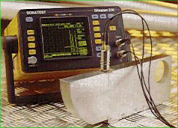Basic Test Theory
Ultrasonic inspection uses sound waves of short wavelength and high frequency to detect flaws or measure material thickness.
Usually pulsed beams of high frequency ultrasound are used via a hand-held transducer which is placed on the specimen. Any sound from that pulse that returns to the transducer like an echo) is shown on a screen which gives the amplitude of the pulse and the time taken to return to the transducer. Defects anywhere through the specimen thickness reflect the sound, back to the transducer. Flaw size, distance and reflectivity can be interpreted.
Applications
Surface and sub-surface flaws, including those too small to be detected other by methods, Especially for detecting subsurface lamination-like defects.
Benefits of the Process
Moderate cost method.
Very sensitive.
Permits probing of joints inaccessible to radiography.
Pulse-echo equipment highly developed for weld inspection purposes.
The transmission-type equipment simplifies pattern interpretation where it is applicable.
Disadvantages/Limitations of the Process
Applicable to ferromagnetic materials only.
Requires skill in interpretation of indications and recognition of irrelevant patterns.
Difficult to use on rough surfaces.
Only surface defects are detectable.
Cannot be used effectively on hot assemblies.
Requires high degree of skill in interpreting pulse-echo patterns.
Permanent record not readily obtained.
Because of it's complexity considerable technician training and skill is required.
Irrelevant surface conditions (smoke, slag) may give misleading indications.
Ultrasonic Process Techniques:
Contact
Submersable
Equipment Needed
Special commercial equipment, either of the pulse-echo or transmission type.
Standard reference patterns for interpretation of RF or video patterns.
Workmanship standards
|

